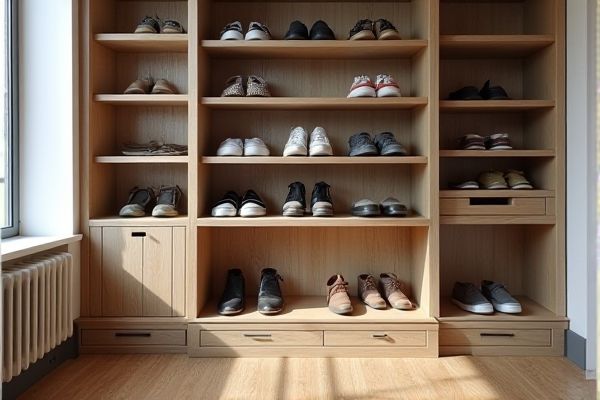
Shoe racks are open shelves that allow easy access and visibility, ideal for quickly grabbing your favorite pair, while shoe cubbies feature individual compartments that keep shoes organized and protected from dust. Understanding the differences can help you decide which option best suits your space and storage needs--read on to explore the benefits of both.
Table of Comparison
| Feature | Shoe Rack | Shoe Cubby |
|---|---|---|
| Design | Open shelves, simple structure | Compartmentalized, divided sections |
| Storage Capacity | Holds multiple pairs, stacked | Individual slots for each shoe pair |
| Organization | Basic shoe placement | Better shoe separation and categorization |
| Space Efficiency | Compact, but less structured | Maximizes vertical and horizontal space |
| Visibility | Easy to see shoes | Shoes visible but within compartments |
| Durability | Usually metal or wood frames | Often made of wood or sturdy plastic |
| Price Range | Affordable to mid-range | Mid-range to higher price |
| Best Use | Quick storage, casual use | Organized storage, long-term use |
Introduction: Shoe Rack vs Shoe Cubby
A shoe rack typically features open shelves designed for easy access and ventilation, making it ideal for quick organization and drying. In contrast, a shoe cubby consists of individual compartments that provide structured storage, helping keep your shoes neatly separated and protected. Choosing between a shoe rack and a shoe cubby depends on your space, shoe collection size, and preference for visibility versus compartmentalized order.
Key Differences Between Shoe Racks and Shoe Cubbies
Shoe racks consist of open shelves designed primarily for holding shoes in a horizontal position, making them ideal for quick access and ventilation. Shoe cubbies feature individual compartments or boxes that separate each pair, offering better organization and prevention of shoe pile-up. The key differences lie in their structure and storage style: shoe racks prioritize space efficiency with stackable shelves, while shoe cubbies emphasize compartmentalized, neat storage that protects shoes from damage and dust.
Space Efficiency: Rack or Cubby?
Shoe cubbies generally offer better space efficiency by providing individual compartments that maximize vertical storage and keep shoes organized without overlapping. Shoe racks, while easier to access and often more compact, can require more horizontal space and may lead to shoe clutter if overpacked. Choosing a shoe cubby can optimize your storage area, especially in tight or multi-use spaces where maintaining order is crucial.
Storage Capacity Comparison
Shoe racks typically offer open shelving that can accommodate a larger number of shoes in various sizes, making them ideal for maximizing storage capacity in tight spaces. Shoe cubbies provide individual compartments, which help organize pairs neatly but may limit the total number of shoes stored due to fixed slot sizes. Your choice depends on whether you prioritize higher volume storage or detailed organization for each pair.
Organization and Accessibility
Shoe racks provide open, tiered shelving designed for quick access and visibility, making them ideal for frequently used footwear. Shoe cubbies offer individual compartments that enhance organization by keeping shoes separated and protected from dust. Both solutions improve home tidiness, but shoe cubbies provide more structured storage while shoe racks prioritize ease of access.
Aesthetic Appeal and Design
Shoe racks typically feature open shelves that offer a minimalist and airy aesthetic, making them ideal for modern or contemporary interiors. Shoe cubbies provide a structured, compartmentalized design that enhances organization while adding a visually pleasing grid pattern to your space. Your choice between the two will depend on whether you prefer a sleek, open look or a more orderly, enclosed display to complement your decor.
Material and Durability Considerations
Shoe racks often feature metal or wood frames that provide sturdy support and long-lasting durability, ideal for heavy or multiple pairs of shoes. Shoe cubbies typically use engineered wood or plastic, offering lightweight and easy-to-clean compartments but potentially sacrificing strength over time. Choosing between the two depends on the need for robust construction versus lightweight, modular design options.
Maintenance and Cleaning
Shoe racks typically feature open shelves that allow for easy access and straightforward dusting, making routine maintenance simple with a quick wipe or vacuum. Shoe cubbies, with their enclosed compartments, may trap dust and require more detailed cleaning inside each cubbyhole, especially if shoes carry dirt or moisture. Both designs benefit from regular airing out to prevent odors, but shoe racks generally offer better airflow and quicker drying for wet shoes.
Ideal Uses and Placement
Shoe racks are ideal for entryways or mudrooms where you need quick access to frequently worn shoes and prefer an open, ventilated design that prevents odor buildup. Shoe cubbies work best in closets or organized spaces where individual compartments keep pairs neatly separated and protected from dust. Your choice depends on the space available and whether you prioritize easy reach or compartmentalized storage for maintaining shoe organization.
Choosing the Best Option for Your Home
Shoe racks offer open, tiered storage that maximizes visibility and air circulation, making them ideal for frequently used footwear and quick access. Shoe cubbies provide individual compartments that keep shoes organized and contained, perfect for maintaining a tidy appearance and storing delicate or seasonal pairs safely. Consider your space, shoe collection size, and aesthetic preferences to choose the best option that fits your home's needs and enhances your organization.
 homyna.com
homyna.com